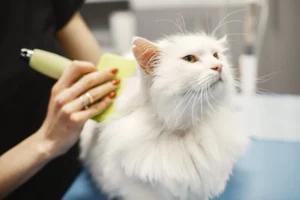Have you ever wondered why your cat always seems to run away as soon as you make eye contact? It can be frustrating and puzzling for cat owners, but there are reasons behind this behavior. Let’s explore why your cat may run away when you look at her.
When you make eye contact with your cat, she may see it as a sign of aggression or dominance, causing her to feel threatened and prompting her to flee. Cats are naturally solitary animals, and direct eye contact can be perceived as a challenge in the feline world. To put it simply, your cat runs away when you look at her because she may interpret it as a threat to her territory or position in the hierarchy.
Body Language Signals
When it comes to understanding why your cat runs away when you look at her, it’s essential to pay attention to her body language signals. Cats communicate through their body movements, and eye contact plays a significant role in these interactions. Direct eye contact can be interpreted as a threat or challenge in the feline world. When your cat feels overwhelmed or anxious, she may resort to running away to alleviate the perceived threat. So, if your cat bolts when you lock eyes with her, it could be a sign that she’s feeling uneasy. Observing her body posture, ear position, and tail movements can provide valuable insights into her emotional state and help you understand her reactions better.
Trust Building Exercises
Building trust with your cat is crucial to create a positive association with eye contact and reduce her fear or anxiety. One effective way to build trust is through positive reinforcement. Offer your cat treats, gentle pets, or playtime whenever she makes eye contact with you. This helps her associate eye contact with pleasant experiences and can gradually increase her comfort level. Another trust-building exercise is slow blinking. Slowly blink your eyes at your cat to mimic a sign of relaxation and trust in the feline world. This can help communicate to your cat that you mean no harm and can help ease her anxieties over time. Remember, building trust takes time and patience, so be consistent with your efforts to strengthen your bond with your feline friend.
? Additional Insight: Cats are crepuscular animals, meaning they are most active during dawn and dusk. Engaging with your cat during these times when she is naturally more alert and active can improve her receptiveness to eye contact and interaction.
Playtime and Enrichment
Want to make your cat feel more comfortable around you? Try engaging in some playtime activities and providing environmental enrichment. By playing with your cat regularly and offering stimulating toys and activities, you can help decrease her stress levels. A happy and engaged cat is more likely to feel at ease around you, even when you’re making eye contact. So, grab that feather wand or laser pointer and watch your feline friend enjoy some quality playtime.
Potential Past Trauma
If your cat runs away when you look at her, it’s possible she may have experienced past trauma or negative experiences. Take a sensitive approach and consider the impact of any previous mistreatment or scary encounters on her behavior. To address this issue, create a safe and peaceful environment for your cat, where she feels secure and protected. Building trust slowly through positive interactions and offering gentle reassurance can help your cat overcome her fear of eye contact. Be patient and understanding as you work to build a stronger bond with your furry companion.
- Set up safe spaces around the house where your cat can retreat if feeling overwhelmed.
- Use calming pheromone diffusers or sprays to help reduce anxiety in your cat.
- Consult with a veterinarian or animal behaviorist for professional guidance and support.
- Provide regular grooming sessions to help your cat relax and feel more at ease in your presence.
By addressing potential past trauma and creating a supportive environment, you can help your cat feel more secure and ultimately strengthen your bond with her.
Seeking Professional Help
If your cat’s fear of eye contact is severe and impacting her quality of life, it may be necessary to seek the assistance of a professional animal behaviorist or veterinarian for guidance and support. These experts have the knowledge and experience to help identify the root cause of your cat’s behavior and can provide personalized strategies to address it effectively. Remember, seeking professional help is a proactive step to ensure your furry friend’s well-being and happiness.
Building a Strong Bond
Learn techniques for strengthening the bond with your cat through positive reinforcement, patience, and understanding to help her feel more secure and confident in your presence. Spend quality time engaging in activities your cat enjoys, such as interactive play sessions or grooming. By creating a positive association with your presence, you can help your cat overcome her fear of eye contact and strengthen the bond between you. Remember, building a strong bond takes time and effort, but the rewards are priceless.
- Provide your cat with plenty of opportunities for play and exploration to help build her confidence.
- Use treats and gentle praise to reinforce positive behaviors and create a positive association with your presence.
- Ensure your cat has a safe and comfortable environment where she can relax and feel secure.
- Consider incorporating interactive toys or puzzles to engage your cat’s mind and build a deeper connection with her.
- Regular veterinary check-ups can help identify any underlying health issues that may be contributing to your cat’s behavior.
Remember, every cat is unique, so be patient and consistent in your efforts to build a strong bond with your furry friend.
Fun Facts About Cat Behavior
Cats are mysterious creatures with unique behaviors that can sometimes leave us scratching our heads. Did you know that when your cat runs away from you when you look at her, it could be a sign of fear or discomfort? Cats are known for their keen senses, and they may perceive eye contact as a threat or a sign of dominance. By looking away or blinking slowly at your cat, you can help alleviate her stress and build trust.
Another interesting fact is that cats have a natural instinct to flee from potential danger. When your cat runs away from you, she may simply be following her innate survival instincts. It’s essential to respect your cat’s boundaries and give her space when she needs it. By creating a safe and comfortable environment for your feline friend, you can help her feel secure and content.
Why Eye Contact Matters
Eye contact plays a significant role in feline communication. Cats use eye contact to establish dominance, express emotions, and communicate with humans and other animals. When your cat runs away from you when you look at her, it may be because she feels intimidated or overwhelmed by your gaze.
To help your cat feel more at ease, try to avoid staring directly into her eyes. Instead, maintain a soft gaze and blink slowly to show that you are not a threat. By using gentle body language and giving your cat the space she needs, you can build a stronger bond based on trust and respect.
Top Tips for Building Trust with Your Cat: 1. Offer treats and rewards to reinforce positive behavior. 2. Create a comfortable and secure environment for your cat. 3. Provide plenty of mental and physical stimulation through play and interaction. 4. Respect your cat’s boundaries and give her space when needed. 5. Consult with a veterinarian or animal behaviorist for additional guidance on building trust with your cat.
By understanding your cat’s behavior and responding to her needs with patience and compassion, you can strengthen your bond and create a loving and trusting relationship.
Alex, a passionate animal lover, has experience in training and understanding animal behavior. As a proud pet parent to two dogs and three cats, he founded AnimalReport.net to share insights from animal experts and expand his knowledge of the animal kingdom.




